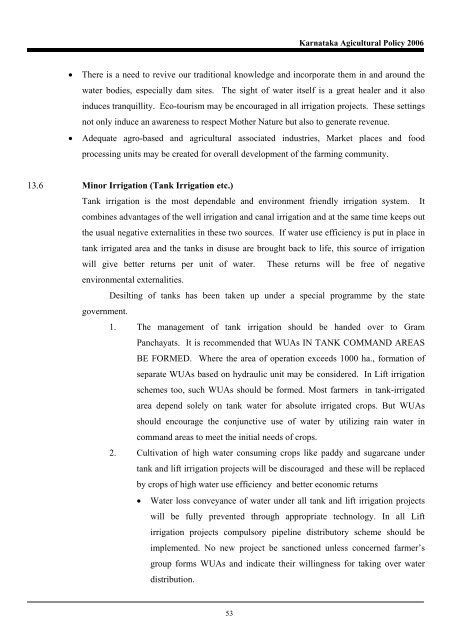Karnataka Agricultural Policy - Institute for Social and Economic ...
Karnataka Agricultural Policy - Institute for Social and Economic ...
Karnataka Agricultural Policy - Institute for Social and Economic ...
You also want an ePaper? Increase the reach of your titles
YUMPU automatically turns print PDFs into web optimized ePapers that Google loves.
<strong>Karnataka</strong> Agicultural <strong>Policy</strong> 2006<br />
• There is a need to revive our traditional knowledge <strong>and</strong> incorporate them in <strong>and</strong> around the<br />
water bodies, especially dam sites. The sight of water itself is a great healer <strong>and</strong> it also<br />
induces tranquillity. Eco-tourism may be encouraged in all irrigation projects. These settings<br />
not only induce an awareness to respect Mother Nature but also to generate revenue.<br />
• Adequate agro-based <strong>and</strong> agricultural associated industries, Market places <strong>and</strong> food<br />
processing units may be created <strong>for</strong> overall development of the farming community.<br />
13.6 Minor Irrigation (Tank Irrigation etc.)<br />
Tank irrigation is the most dependable <strong>and</strong> environment friendly irrigation system. It<br />
combines advantages of the well irrigation <strong>and</strong> canal irrigation <strong>and</strong> at the same time keeps out<br />
the usual negative externalities in these two sources. If water use efficiency is put in place in<br />
tank irrigated area <strong>and</strong> the tanks in disuse are brought back to life, this source of irrigation<br />
will give better returns per unit of water. These returns will be free of negative<br />
environmental externalities.<br />
Desilting of tanks has been taken up under a special programme by the state<br />
government.<br />
1. The management of tank irrigation should be h<strong>and</strong>ed over to Gram<br />
Panchayats. It is recommended that WUAs IN TANK COMMAND AREAS<br />
BE FORMED. Where the area of operation exceeds 1000 ha., <strong>for</strong>mation of<br />
separate WUAs based on hydraulic unit may be considered. In Lift irrigation<br />
schemes too, such WUAs should be <strong>for</strong>med. Most farmers in tank-irrigated<br />
area depend solely on tank water <strong>for</strong> absolute irrigated crops. But WUAs<br />
should encourage the conjunctive use of water by utilizing rain water in<br />
comm<strong>and</strong> areas to meet the initial needs of crops.<br />
2. Cultivation of high water consuming crops like paddy <strong>and</strong> sugarcane under<br />
tank <strong>and</strong> lift irrigation projects will be discouraged <strong>and</strong> these will be replaced<br />
by crops of high water use efficiency <strong>and</strong> better economic returns<br />
• Water loss conveyance of water under all tank <strong>and</strong> lift irrigation projects<br />
will be fully prevented through appropriate technology. In all Lift<br />
irrigation projects compulsory pipeline distributory scheme should be<br />
implemented. No new project be sanctioned unless concerned farmer’s<br />
group <strong>for</strong>ms WUAs <strong>and</strong> indicate their willingness <strong>for</strong> taking over water<br />
distribution.<br />
53

















